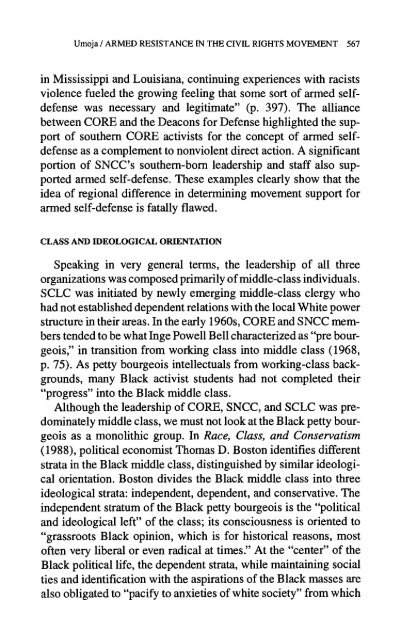MXGM Self-Defence Manual
MXGM Self-Defence Manual
MXGM Self-Defence Manual
You also want an ePaper? Increase the reach of your titles
YUMPU automatically turns print PDFs into web optimized ePapers that Google loves.
Umoja / ARMED RESISTANCE IN THE CIVIL RIGHTS MOVEMENT 567<br />
in Mississippi and Louisiana, continuing experiences with racists<br />
violence fueled the growing feeling that some sort of armed selfdefense<br />
was necessary and legitimate" (p. 397). The alliance<br />
between CORE and the Deacons for Defense highlighted the support<br />
of southern CORE activists for the concept of armed selfdefense<br />
as a complement to nonviolent direct action. A significant<br />
portion of SNCC's southern-born leadership and staff also supported<br />
armed self-defense. These examples clearly show that the<br />
idea of regional difference in determining movement support for<br />
armed self-defense is fatally flawed.<br />
CLASS AND IDEOLOGICAL ORIENTATION<br />
Speaking in very general terms, the leadership of all three<br />
organizations was composed primarily of middle-class individuals.<br />
SCLC was initiated by newly emerging middle-class clergy who<br />
had not established dependent relations with the local White power<br />
structure in their areas. In the early 1960s, CORE and SNCC members<br />
tended to be what Inge Powell Bell characterized as "pre bourgeois,"<br />
in transition from working class into middle class (1968,<br />
p. 75). As petty bourgeois intellectuals from working-class backgrounds,<br />
many Black activist students had not completed their<br />
"progress" into the Black middle class.<br />
Although the leadership of CORE, SNCC, and SCLC was predominately<br />
middle class, we must not look at the Black petty bourgeois<br />
as a monolithic group. In Race, Class, and Conservatism<br />
(1988), political economist Thomas D. Boston identifies different<br />
strata in the Black middle class, distinguished by similar ideological<br />
orientation. Boston divides the Black middle class into three<br />
ideological strata: independent, dependent, and conservative. The<br />
independent stratum of the Black petty bourgeois is the "political<br />
and ideological left" of the class; its consciousness is oriented to<br />
"grassroots Black opinion, which is for historical reasons, most<br />
often very liberal or even radical at times." At the "center" of the<br />
Black political life, the dependent strata, while maintaining social<br />
ties and identification with the aspirations of the Black masses are<br />
also obligated to "pacify to anxieties of white society" from which


